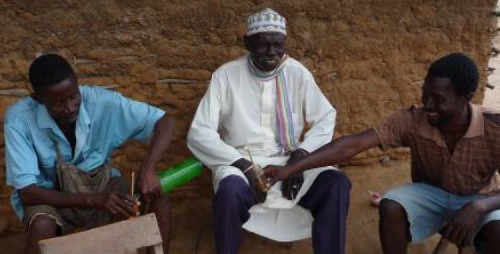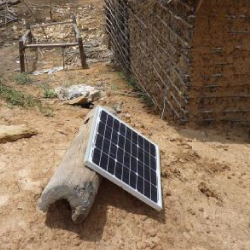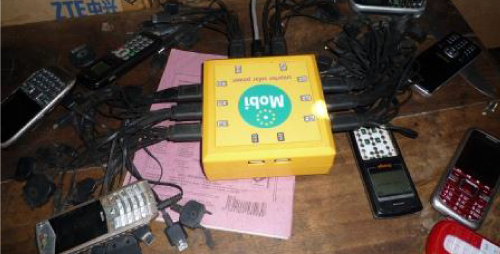The is a guest post by Simon Collings, Chief Operations Officer at GVEP International.
In the remote communities around Ganze, near the Kenyan coast, charging a mobile phone is a major challenge. The nearest source of electricity may be 15-20 km away, about a three hour walk. Typically, communities gather their phones together and someone takes them and deposits them at a charging kiosk in Ganze. Two days later, someone else makes the same journey to collect the charged phones. As a result, residents of the remote communities are without mobile communications for days at a time, and often turn off their phones to preserve battery, impacting their business activities and reducing their ability to keep in contact with friends or family. Many fear losing their phones while they are away being charged.
But in one community 15 kilometres from Ganze, things are changing. Samuel Kapelekesho started providing a phone charging service from his grocery shop four months ago, bringing significant benefits to him and the community. Since he started charging phones, sales of goods at his shop have increased. Samuel also sells the local hooch, called Mnazi, which is made from fermented coconut milk. Many of his customers like to share a drink while they wait the two hours for their phone to charge. He has a lot of happy customers!
Samuel is one of ten entrepreneurs participating in a trial of a solar phone charging unit called Mobi, developed by award winning company Azuri. The compact battery unit, solar panel and two LED lights, has been designed to operate on a ‘pay-as-you-go’ basis similar to Indigo, the company’s home lighting product. An entrepreneur pays a deposit to acquire the system and then pays a monthly fee to access a code which is used to reactivate the system through a key pad on the unit. Payments are made through mobile money.
The ten participants in the trial were recruited by GVEP International which advertised the business opportunity and screened over one hundred applicants. GVEP staff provide business coaching for the participating entrepreneurs and are gathering data on the trial. I visited all ten entrepreneurs during October, with Azuri staff joining me for some of the visits.
Four months in, all of the participants in the trial say they are happy with the units. Mobi is much easier to use than a conventional solar system. It requires no maintenance and the simple plug and play design makes it easy to install. The units charge phones more quickly than a conventional system and the phones hold their charge for longer. The two LED lights which come as part of the kit will operate throughout the night and have enabled the entrepreneurs to eliminate kerosene from their homes and shops. There is a considerable saving in expenditure.
Fifty miles away from Ganze, another Mobi entrepreneur, John Kadzoyo runs an electrical store just off the main Mombasa/Nairobi highway. His Mobi unit is operated by his wife from their home some kilometres off the road. She is able to use the cash she earns to meet household expenditures. Before they had Mobi, the family kept small kerosene lamps burning during the night. ‘When we woke in the morning we had soot around our nostrils,’ John told me.
Although nine out of ten of the entrepreneurs who signed up for Mobi are men, half of the units are actually operated by women – wife, mother, daughter or employee. Ruben Kobe, who has a welding shop in Kaloleni has set his daughter, Jessica, up in business with the Mobi unit he acquired. ‘She has a baby,’ he explains. ‘With Mobi she now has money for her needs and I do not have to worry about providing for her. Without Mobi she would just have been idle.’
In one location the entrepreneur who acquired Mobi has installed it in a community school where he is on the governing committee. The school has no electricity and the Mobi unit LEDs have been used to provide light for exam preparation classes held in the evening. Previously the school used kerosene lights. The students bring in their parents’ phones when they come to school and take back the recharged phones in the evening.
In many locations competition is growing with many charging stations setting up. Phone ownership is still growing, as is the use of phones (airtime.) The standard rate for charging a phone is 20 shillings (US25 cents.) In two places Mobi operators were charging 15 shillings, and in one of those places a competitor was charging 10 shillings. We have been expecting to see price competition emerge for a while but this is the first time I have actually seen it.
Most of the entrepreneurs using Mobi had operated a phone charging service before using a conventional set up. A few are completely new to the venture. All appreciate the monthly payment system, everyone has been topping up regularly, and all say they plan to continue until they have bought the system. From the phone charging revenue, other additional revenue and savings on kerosene, the monthly top up was affordable for even the weakest performing business. All believe that they can hold their own against competitors because of the lower cost and higher performance of the Mobi unit.
Useful feedback was gathered on features which could be further improved. Azuri are now reviewing next steps with the ambition of starting to roll out an iterated version of Mobi at greater scale. A full evaluation of the trial will be completed by GVEP after a further two months of operation. But the preliminary findings appear to be very encouraging.





